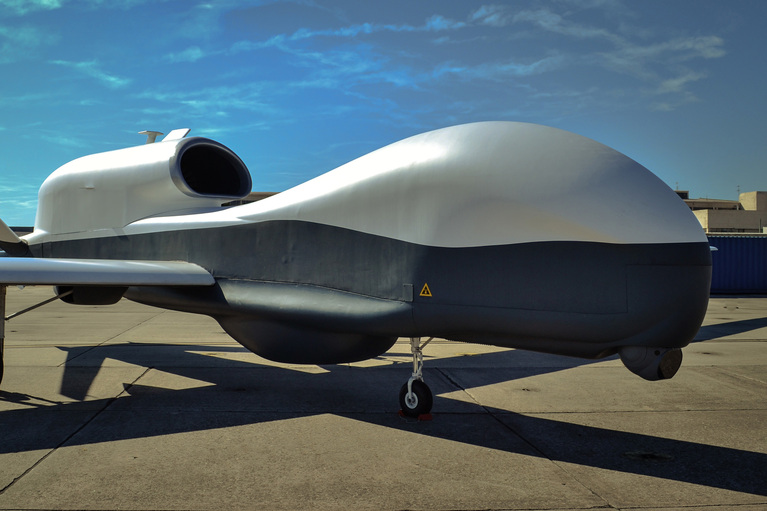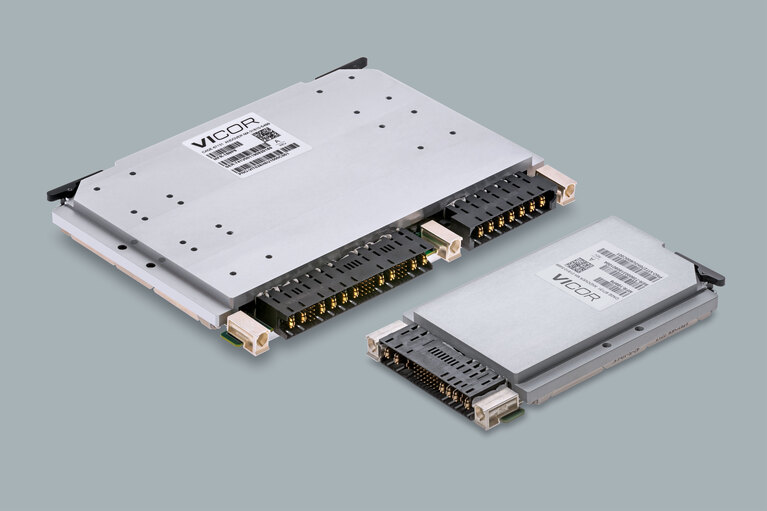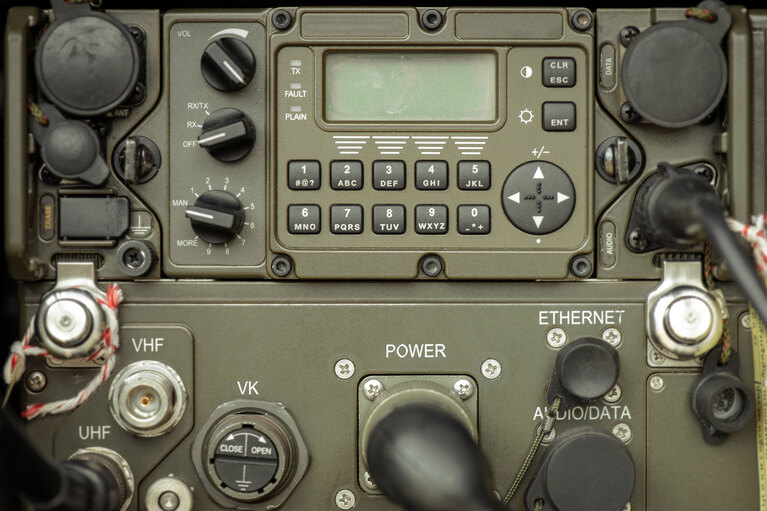
Supporting more functionality, increased payload and longer run time
Learn how Vicor delivers high power with efficiency and reduced weight that allows for greater payload options to support mission success
This quick and handy reference of commonly used terms will help you navigate and understand the complex language of the defense industry.
By Matt Renola, Sr. Director Global Sales Aerospace and Defense
The signal used to indicate the presence of AC input voltage from the 115/230V line.
Performed on products to determine the proper functionality of equipment in airplanes and other flying objects. MIL-STD-810.
The temperature of the environment, usually the still air in the immediate proximity of the power supply.
A value of power for AC circuits that is calculated as the product of RMS current times RMS voltage, without taking power factor into account.
A range of frequencies over which a certain phenomenon is to be considered.
All legacy brick modular products have an aluminum mounting base at which Vicor specifies operating temperatures and which should be affixed to a thermally conductive surface for cooling.
A “child” module in a driver/booster combination, where the driver is the parent. Several boosters can be paralleled with a driver module for higher output power.
A voltage level at which dielectric insulation fails by excessive leakage current or arcing. In reference to power supplies the breakdown voltage is the maximum AC or DC voltage that can be applied from input to output and/or chassis.
A DC-DC converter topology (configuration) employing two or four active switching components in a bridge configuration across a power transformer.
A full wave rectifier circuit employing four or more rectifiers in a bridge configuration utilized to convert (AC) current to (DC) current.
A reduction of the AC mains distribution voltage, usually caused deliberately by the utility company to reduce power consumption when demand exceeds generation or distribution capacity.
Operating a newly manufactured power supply, usually at rated load, for a period of time in order to force component infant mortality failures or other latent defects.
Coupling of a signal between two circuits, due to discrete or parasitic capacitance between the circuits.
An electrical connection made at the center of a transformer or inductor winding, usually so as to result in an equal number of turns on either side of the tap.
A configuration where the modules or AC front ends are mounted directly to the chassis.
Converter housed in a Package.
Noise present equally on two conductors with respect to some reference point; often used specifically to refer to noise present on both the hot and neutral AC lines with respect to ground.
A power supply designed to regulate output current due to changes in line, load, ambient temperature and drift over time.
A power supply designed to regulate output voltage for changes in line, load, ambient temperature and drift resulting over time.
A circuit in a closed-loop system, typically containing an error amplifier, that controls the operation of the system to achieve regulation.
An electrical circuit that accepts a DC input and generates a DC output of a different voltage usually achieved by high frequency switching action employing inductive and capacitive filter elements.
Commercial off-the-shelf or commercially available off-the-shelf (COTS) products are packaged or canned (ready-made) hardware or software, which are adapted aftermarket to the needs of the purchasing organization, rather than the commissioning of custom-made, or bespoke solutions.
In an AC circuit, the mathematical ratio of the peak to RMS values of a waveform. Crest factor is sometimes used for describing the current stress in AC mains supply wires, since for a given amount of power transferred, the RMS value, and hence the losses, become greater with increasing peak values. Crest factor gives essentially the same information as power factor, and is being replaced by power factor in power supply technology.
The effect of a load change on one output to the regulation of another output. It usually only applies to non post-regulated (quasi) outputs.
An overvoltage protection method that shorts the power supply output to ground in order to protect the load when an overvoltage fault is detected.
An overload protection circuit that limits the maximum output current of a power supply in order to protect the load and/or the power supply.
A control method for switch-mode converters where the converter adjusts its regulating pulse width in response to measured output current and output voltage, using a dual loop control circuit.
An analog power supply signal that is linearly proportional to output current flow.
The DCM™ is an isolated, regulated DC-DC converter.
Signal used to monitor the status of the DC output.
A reduction in an operating specification to improve reliability. For power supplies it is usually a specified reduction in output power to facilitate operation at higher temperatures.
The expected lifetime of a power supply during which it will operate to its published specifications.
Noise that is measured between two lines with respect to a common reference point excluding common-mode noise. The resultant measurement is the difference of the noise components of the two lines. The noise between the DC output and DC return is usually measured in power supplies.
The change in an output voltage, after a warm-up period, as a function of time when all other variables such as line, load and operating temperature are held constant.
The controlling module in a standalone or driver/booster configuration. The driver module contains all the control circuitry.
The lower limit of the AC input voltage where the power supply just begins to experience insufficient input to maintain regulation. The dropout voltage for linears is largely line dependent, whereas for most switchers it is largely load dependent, and to a smaller degree line dependent.
The delta in output voltage when the output load is rapidly changed.
The ratio of total output power to input power expressed as a percentage.
An electronic device designed to provide a load to the outputs of a power supply, usually capable of dynamic loading, and frequently programmable or computer controlled.
Electromagnetic compatibility. Relating to compliance with electromagnetic emissions and susceptibility standards.
Electromagnetic interference. The generation of unwanted noise during the operation of a power supply or other electrical or electronic equipment.
Equivalent series resistance. The value of resistance in series with an ideal capacitor that duplicates the performance characteristics of a real capacitor.
A power distribution architecture that is inherently more granular and leverages an allocation of the DC-DC converter functions consistent with efficient power distribution principles. An optimal power distribution architecture should efficiently support demanding low voltage, high current loads. FPA is a higher level power architecture that offers dramatic improvements in onboard power distribution systems, in performance, reliability and economy.
A method of parallel operation, using output Oring diodes, in which the failure of a single supply (module) will not result in a loss of power. The total current of the parallel system must not exceed the load requirements to a point where the failure of a single unit will not result in a system overload.
Field effect transistor. A majority carrier-voltage controlled transistor.
An output of a power supply that is not connected or referenced to any other output, usually denoting full galvanic isolation. Floating outputs can generally be used as either positive or negative outputs. Non-floating outputs share a common return line and are hence DC referenced to one another.
A type of protection circuit where the output current decreases as the overload increases. The output current reaches a minimum as the load approaches a short circuit condition.
A switching power supply in which the energy is transferred from the input to the output during the “on” time of the primary switching device.
The GATE IN pin of the module may be used to turn the module on or off. When GATE IN is pulled low, the module is turned off. When GATE IN is floating (open collector) the module is turned on. The open circuit voltage of the GATE IN pin is less than 10V, referenced to –VIN. A GATE OUT/GATE IN connection is necessary to run driver / booster configurations.
The GATE OUT pin is the clock pulse of the converter. It is used to synchronize booster modules to a Driver module for high power arrays.
An electrical connection to earth or some other conductor that is connected to earth. Sometimes the term “ground” is used in place of “common,” but such usage is not correct unless the connection is also connected to earth.
An unintentionally induced feedback loop caused by two or more circuits sharing a common electrical ground.
A waveform that is sinusoidal in nature, but consists of a portion of a sine wave superimposed on another waveform. The input current waveform to a typical offline power supply has the form of a haversine.
Used in conjunction with series pass regulators, headroom is the difference between the input and output voltages.
A medium of high thermal mass that can absorb (sink) heat indefinitely with negligible change in temperature. Heat sinks are not necessarily needed with Vicor modules, and their use is highly dependent on the individual application, power and ambient temperature.
The maximum steady-state input voltage on the input pin.
Abbreviation for high potential, and generally refers to the high voltages used to test dielectric withstand capability for regulatory agency electrical safety requirements.
A capacitor whose energy is used to provide output voltage for a period after the removal of input voltage.
The length of time a power supply can operate in regulation after failure of the AC input. Linears have very short hold-up times due to the energy stored on the low-voltage secondary side output capacitors. Switchers have longer times due to higher-voltage primary-side energy storage capacitors.
Insertion and extraction of a power supply into a system while power is applied.
The ratio of voltage to current at a specified frequency.
Noise generated in a circuit by varying a magnetic field produced by another circuit.
An internally or externally mounted lowpass or band-reject filter at the power supply input that reduces the noise fed into the power supply.
The peak current flowing into a power supply the instant AC power is applied. This peak may be much higher than the steady state input current due to the charging of the input filter capacitors.
A circuit that limits the amount of inrush current when a power supply is turned on. Isolation: Two circuits that are completely electrically separated with respect to DC potentials, and almost always AC potentials. In power supplies, it is defined as the electrical separation of the input and output via the transformer.
The maximum AC or DC test voltage that may be applied from input to output and/or chassis of a power supply. Usually this has a time limit per preregulatory agency such as EN60950.
A term relating to current flowing between the AC supply wires and earth ground. The term does not necessarily denote a fault condition. In power supplies, leakage current usually refers to the 60Hz current that flows through the EMC filter capacitors connected between the AC lines and ground (Y caps).
A regulating technique where a dissipative active device such as a transistor is placed in series with a power supply output to regulate the output voltage.
The change in output voltage when the AC input voltage is changed from minimum to maximum specified.
The sine wave voltage provided to the power supply, usually expressed in volts RMS.
The change in output voltage when the load on the output is changed.
Using the voltage output terminals of the power supply as sense points for voltage regulation.
Power supply output voltage change due to time with all other factors held constant. This is expressed in percent and is a function of component aging.
The minimum steady state voltage that can be applied between the +IN and –IN pins of a converter and still maintain output regulation.
The utility AC power distribution wires.
Adjusting a power supply output voltage up or down from its nominal setting in order to verify system performance margin with respect to supply voltage. This is usually done electrically by a system-generated control signal.
An industry standard where the operating temperature extends down to –55°C.
Military standards that a device must meet to be used in military environments.
A United States Military standard that describes how to test equipment for electromagnetic compatibility.
United States Military Standard that defines a standardized power interface between a military aircraft and its equipment and carriage stores, covering such topics as voltage, frequency, phase, power factor, ripple, maximum current, electrical noise and abnormal conditions (overvoltage and undervoltage), for both AC and DC systems.
United States military Standard that that defines nominal 28VDC voltage characteristics that are common to all military ground vehicles, specifically at the input power terminal of electronic/electrical assemblies that are directly connected to the distribution network in question. MIL-STD-1275 establishes a framework for similarity throughout military vehicle platforms. Design authorities are charged with making sure the 28VDC applied to the input power terminal of the equipment meets MIL‑STD-1275 requirements. This standard does not relate to power sources or power systems, but instead focuses on utilization equipment and required operating conditions.
United States military standard approved for use by the Naval Sea Systems Command, Department of the Navy, and is available for use by all Departments and Agencies of the Department of Defense. The purpose of MIL STD 1399 is to define the standard interface requirements and constraints applicable on the design of shipboard user equipment that will utilize shipboard alternating current (at) electric power.
MTBF is the point at which 63% of a given population no longer meet specification. It can either be calculated or demonstrated. The usual calculation is per MIL-STD-217 Rev. E. Demonstrated reliability is usually determined by temperature accelerated life testing and is usually greater than calculated MTBF.
The center value for the input voltage range.
A usual, average, normal, or expected operating condition. This stated value will probably not be equal to the value actually measured.
A power supply that receives its input power from the AC line, without using a 50/60Hz power transformer prior to rectification and filtering, hence the term “offline” power supply.
The range of temperatures in which a unit can operate within specifications.
An electro-optical device that transmits a signal across a DC isolation boundary.
Diodes used to isolate supplies from one another under a fault condition.
Filter used to reduce switching power supply noise and ripple.
A power supply status signal that indicates the output voltage is within a certain tolerance. An output that is either too high or too low will deactivate the output good signal.
The ratio of change in output voltage to change in load current.
The AC component that may be present on the DC output of a power supply. Switch-mode power supply output noise usually has two components: a lower frequency component at the switching frequency of the converter and a high frequency component due to fast edges of the converter switching transitions. Noise should always be measured directly at the output terminals with a scope probe having an extremely short grounding lead.
The maximum power in watts that the power supply can provide and still maintain safety agency approvals.
See setpoint accuracy.
A power supply protection circuit that limits the output current under overload conditions.
A transient output voltage change exceeding the high limit of the voltage accuracy specification caused by turning the power supply on or off, or abruptly changing line or load conditions.
A TTL compatible signal that indicates an overtemperature condition exists in the power supply.
A circuit that either shuts down the power supply or crowbars the output in the event of an output overvoltage condition.
Connecting the outputs of two or more power supplies together for the purpose of obtaining a higher output current. This requires power supplies specially designed for load sharing.
Periodic and random deviation. Referring to the sum of all ripple and noise components on the DC output of a power supply, regardless of nature or source.
The absolute maximum output power that a power supply can produce without immediate damage. Peak power capability is typically well beyond the continuous output power capability and the resulting average power should not exceed rated specifications.
A commonly used filter at the input of a switching supply or DC-DC converter to reduce reflected ripple current. The filter usually consists of two shunt capacitors with inductance between them.
A secondary regulating circuit on an auxiliary output of a power supply that provides regulation on that output.
A power supply interface signal that gives a warning that the input voltage will no longer sustain full power regulated output.
The ratio of true power to apparent power in an AC circuit. In power conversion technology, power factor is used in conjunction with describing AC input current to the power supply.
A small amount of current drawn from a power supply to stabilize its operation.
The input section of an isolated power supply, it is connected to the AC mains and hence has dangerous voltage levels present.
The environmental and acceptance tests performed on Vicor products.
A switching power conversion technique where the on-time (or width) of a duty cycle is modulated to control power transfer for regulating power supply outputs.
A switch-mode power supply topology that utilizes a center-tapped transformer and two power switches. The two switches are alternately driven on and off.
The regulation of an auxiliary output that is accomplished by regulation of the main output. A transformer turns ratio, commensurate with the desired auxiliary output voltage, is used in conjunction with the output around which the main control loop is closed. Quasi-regulated outputs are significantly affected by second order effects in the converter.
The maximum load current that a power supply can provide at a specified ambient temperature.
The RMS or peak-to-peak AC current present at the input of the power supply that is a result of the switching frequency of the converter.
The ability of a power supply to maintain an output voltage within a specified tolerance as referenced to changing conditions of input voltage and/or load.
The total error band allowable for an output voltage. This includes the effects of all of the types of regulation: line, load, temperature and time.
CSA: Canadian Standards Association; FCC: Federal Communications Commission; FTZ: Fernmelde Technisches Zentralamt; TÜV: Technischer Überwachungs Verein; U.L.: Underwriters Laboratory; VDE: Verband Deutscher Electrotechniker.
A power supply interface signal, usually TTL compatible, that commands the power supply to shut down one or all outputs.
Enables power supply to be remotely turned on or off. Turn-on is typically performed by open circuit or TTL logic “1”, and turn-off by switch closure or TTL logic “0”.
Wires connected in parallel with power supply output cables such that the power supply can sense the actual voltage at the load to compensate for voltage drops in the output cables and/or isolation devices.
The designation of the common terminal for the power supply outputs. It carries the return current for the outputs.
A protection circuit that prevents the power supply from being damaged in the event that a reverse voltage is applied at the input or output terminals.
Radio frequency interference. Undesirable noise produced by a power supply or other electrical or electronic device during its operation. In power supply technology, RFI is usually taken to mean the same thing as EMC.
The amplitude of the AC component on the DC output of a power supply usually expressed in millivolts peak-to-peak or RMS. For a linear power supply it is usually at the frequency of the AC mains. For a switching power supply, it is usually at the switching frequency of the converter stage.
A conductive path to earth that is designed to protect persons from electrical shock by shunting away any dangerous currents that might occur due to malfunction or accident.
The output section of an isolated power supply, it is isolated from the AC mains and specially designed for safety of personnel who might be working with power on the system.
An acronym for Safety Extra Low Voltage, a term generally defined by the regulatory agencies as the highest voltage that can be contacted by a person and not cause injury. It is often specifically defined as 30VAC or 42.4VDC.
Ratio of actual to specified output voltage.
The technique of establishing a desired order of activating the outputs of a multiple output power supply.
A technique for gradually activating a power supply circuit when the power supply is first turned on. This technique is generally used to provide a gradual rise in output voltages and inrush current limiting.
A condition where there is substantial impedance present in the AC mains feeding input power to a power supply. The input voltage to the power supply drops significantly with increasing load.
The input current drawn by a power supply when shut down by a control input (remote inhibit) or under no load.
A condition where there is no significant impedance present in the AC mains feeding input power to a power supply. The input voltage to the power supply does not change appreciably with load.
The rate at which the DC voltage is switched on and off in a switching power supply.
The average output voltage change expressed as a percent per degree celsius of ambient temperature change. This is usually specified for a predetermined temperature range.
Reducing the output power of a power supply with increasing temperature to maintain reliable operation.
A phase change material (ThermMate) used as a thermal interface between the converter and a heat sink or chassis.
A power supply protection circuit that shuts the power supply down in the event of unacceptably high internal temperatures.
The design type of a converter, indicative of the configuration of switching transistors, utilization of the transformer, and type of filtering. Examples of topologies are the flyback, forward, half bridge, full bridge, resonant and zero-current switching.
A characteristic in a multiple output power supply where any changes in the output voltage of one output caused by line, load, and/or temperature are proportional to similar changes in accompanying outputs.
The time required for an output voltage to be within specified accuracy limits after a step change in line or load conditions.
In an AC circuit, true power is the actual power consumed. It is distinguished from apparent power by eliminating the reactive power component that may be present.
The difference in magnitudes, in percent, of two output voltages that have equal nominal voltage magnitudes but opposite polarities.
A method of closed loop control of a switching converter to correct for changes in the output voltage.
The initial change in the output voltage of a power supply in the time period between turn-on and when the power supply reaches thermal equilibrium at 25°C, full load and nominal line.
The time required after initial turn-on for a power supply to achieve compliance to its performance specifications.
A capacitor connected across the supply lines to suppress normal mode interference.
Power conversion modules generally require bypass capacitors from line to chassis (earth ground) to shunt common mode noise currents and keep them local to the converter. In cases where the converters are operating from rectified AC line voltage, the failure of a bypass capacitor could result in excessive leakage current to the equipment chassis thus creating a ground fault and shock hazard. For this reason, a special classification of capacitor, referred to as a Y-capacitor, is recommended. These capacitors contain a dielectric with unique “self-healing” properties to help prevent against excessive leakage.
The turn-on and turn-off of a switching device at zero current, resulting in essentially lossless switching. The zero-current-switching topology allows Vicor converters to operate at frequencies up to 1MHz, with efficiencies higher than 80% and power densities greater than conventional topologies.
This technique significantly minimizes the switching losses and dV/dt noise due to the discharge of the switching MOSFET junction capacitance and reverse recovery of the diode, and enables switch mode converters to operate at higher frequencies.
Matt Renola is Senior Director, Global Business Development – Aerospace, Defense and Satellite Business Unit at Vicor. Matt has been with Vicor for 15 years and has been responsible for managing the Vicor sales teams and global accounts in all of Vicor main vertical markets. He has over 30 years of technical sales and marketing experience and has also worked for major OEMs: Artesyn Technologies, Emerson Network Power and Vishay Intertechnology. He has an undergraduate degree from Boston College and an MSE from the University of Pennsylvania.
Matt Renola, Sr. Director Global Sales Aerospace and Defense
Rugged, efficient, high-power solutions enabling longer missions and advanced defense capabilities
Case study: Aircraft gets an 11kW power supply the size of a tablet computer
Article: Defense-electronics spending seeks to overcome COVID-19 setbacks in key applications
Modules for aerospace and defense applications
Supporting more functionality, increased payload and longer run time
Learn how Vicor delivers high power with efficiency and reduced weight that allows for greater payload options to support mission success
Compact, efficient power solutions enable improved countermeasure capabilities
Explore Vicor's efficient and reduced weight power delivery network for electronic warfare countermeasures systems
Reducing I2R losses to enable extended missions
Learn how Vicor delivers high power with efficiency and reduced weight for electronic countermeasures
Providing well-regulated 48V at over 1kW
Learn how Vicor delivers power at 1kW with efficiency and reduced weight








